Health Literacy and Patient Empowerment
VerifiedAdded on 2020/02/23
|12
|2694
|44
AI Summary
This assignment examines the crucial link between health literacy and patient empowerment in healthcare communication. It delves into various aspects of this relationship, drawing upon research studies such as the European Health Literacy Survey (HLS-EU) and focusing on the unique challenges faced by Indigenous Australian communities regarding cancer discussion and treatment access. The provided research papers offer insights into these complex issues.
Contribute Materials
Your contribution can guide someone’s learning journey. Share your
documents today.
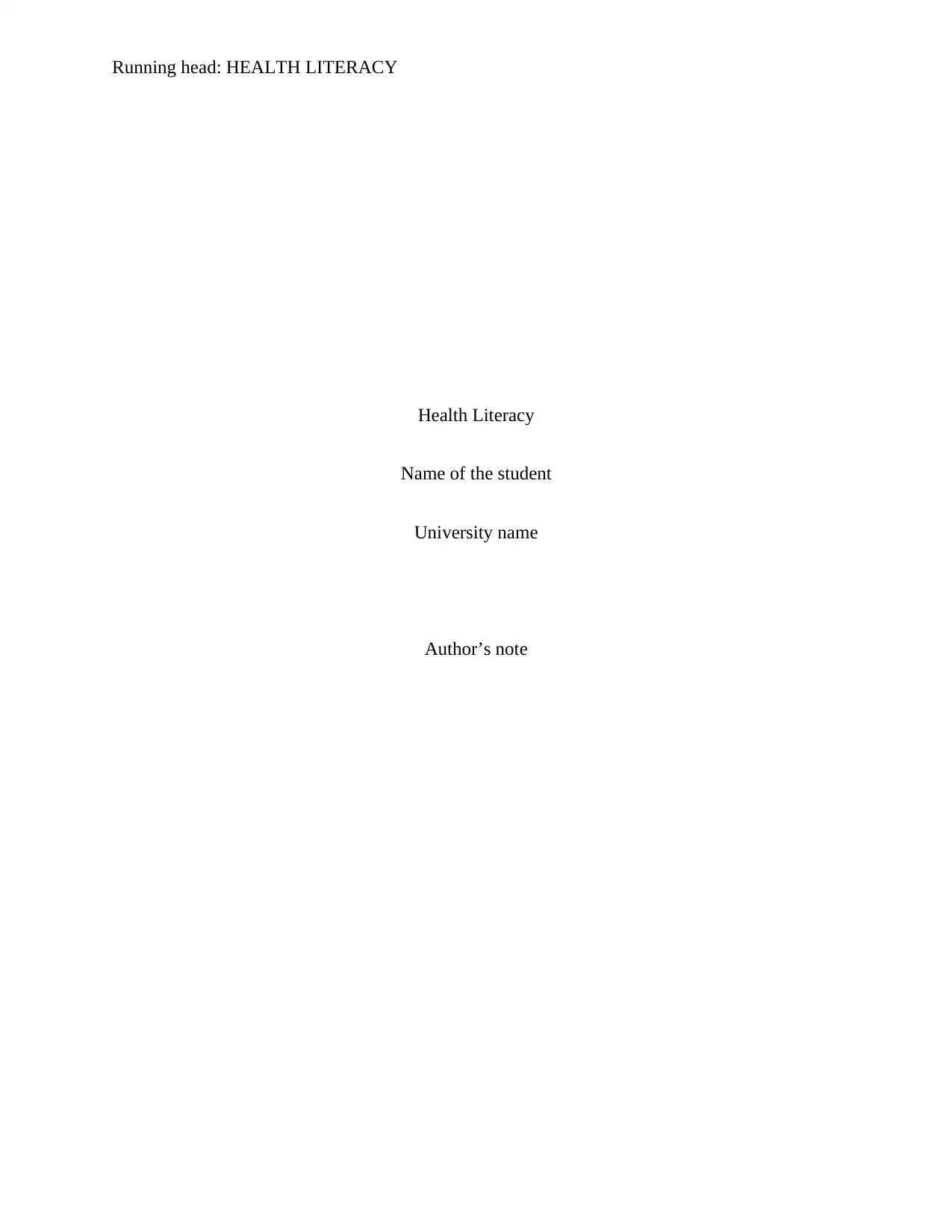
Running head: HEALTH LITERACY
Health Literacy
Name of the student
University name
Author’s note
Health Literacy
Name of the student
University name
Author’s note
Secure Best Marks with AI Grader
Need help grading? Try our AI Grader for instant feedback on your assignments.
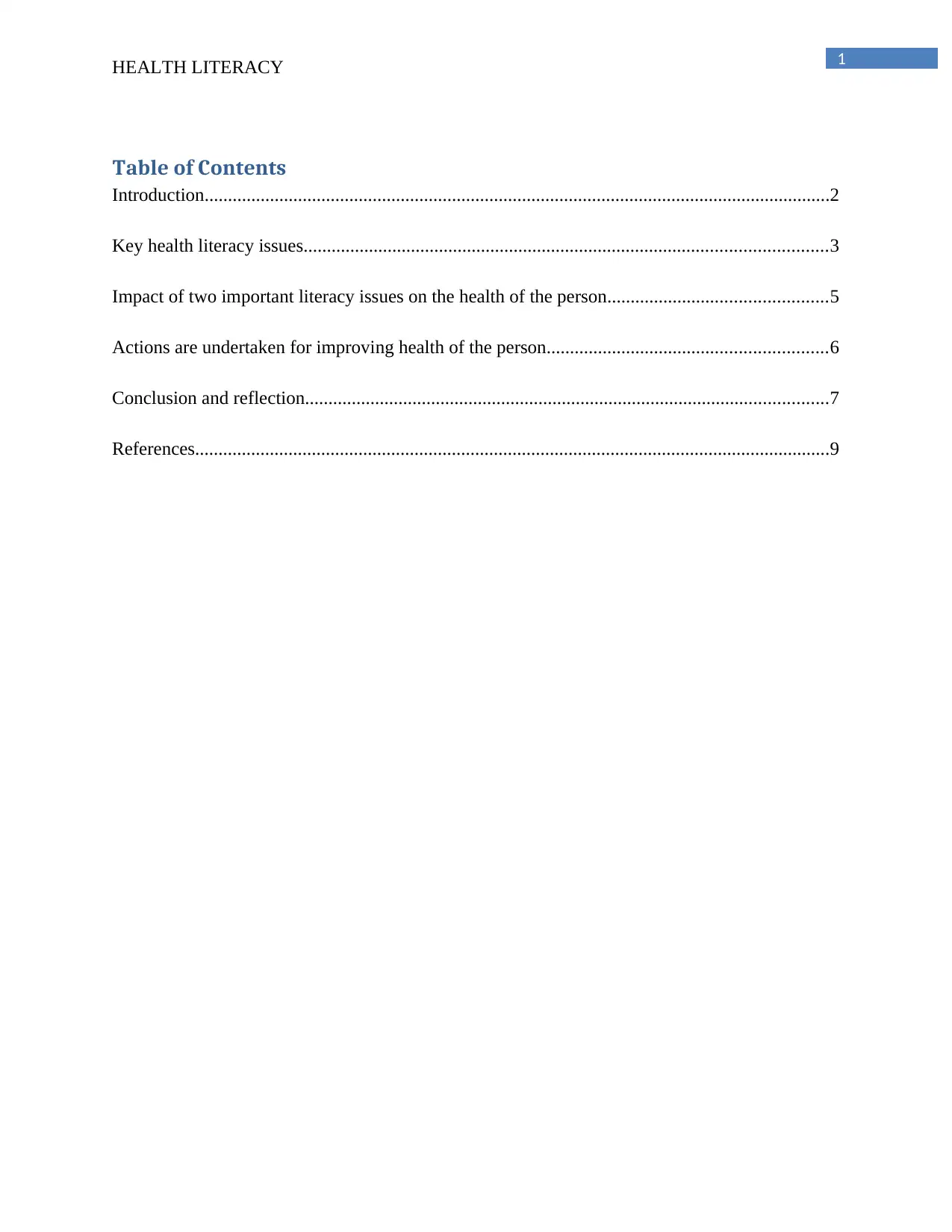
1HEALTH LITERACY
Table of Contents
Introduction......................................................................................................................................2
Key health literacy issues................................................................................................................3
Impact of two important literacy issues on the health of the person...............................................5
Actions are undertaken for improving health of the person............................................................6
Conclusion and reflection................................................................................................................7
References........................................................................................................................................9
Table of Contents
Introduction......................................................................................................................................2
Key health literacy issues................................................................................................................3
Impact of two important literacy issues on the health of the person...............................................5
Actions are undertaken for improving health of the person............................................................6
Conclusion and reflection................................................................................................................7
References........................................................................................................................................9
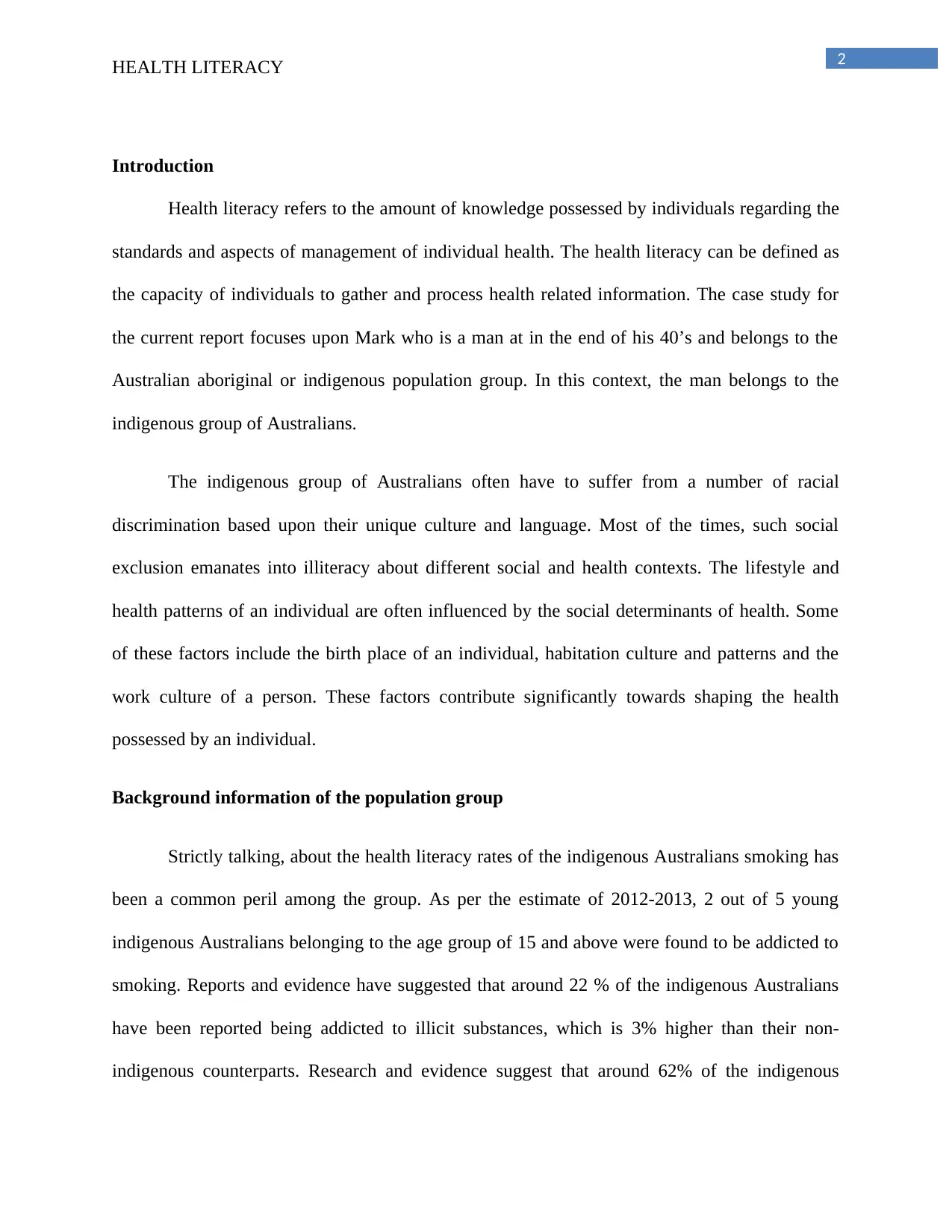
2HEALTH LITERACY
Introduction
Health literacy refers to the amount of knowledge possessed by individuals regarding the
standards and aspects of management of individual health. The health literacy can be defined as
the capacity of individuals to gather and process health related information. The case study for
the current report focuses upon Mark who is a man at in the end of his 40’s and belongs to the
Australian aboriginal or indigenous population group. In this context, the man belongs to the
indigenous group of Australians.
The indigenous group of Australians often have to suffer from a number of racial
discrimination based upon their unique culture and language. Most of the times, such social
exclusion emanates into illiteracy about different social and health contexts. The lifestyle and
health patterns of an individual are often influenced by the social determinants of health. Some
of these factors include the birth place of an individual, habitation culture and patterns and the
work culture of a person. These factors contribute significantly towards shaping the health
possessed by an individual.
Background information of the population group
Strictly talking, about the health literacy rates of the indigenous Australians smoking has
been a common peril among the group. As per the estimate of 2012-2013, 2 out of 5 young
indigenous Australians belonging to the age group of 15 and above were found to be addicted to
smoking. Reports and evidence have suggested that around 22 % of the indigenous Australians
have been reported being addicted to illicit substances, which is 3% higher than their non-
indigenous counterparts. Research and evidence suggest that around 62% of the indigenous
Introduction
Health literacy refers to the amount of knowledge possessed by individuals regarding the
standards and aspects of management of individual health. The health literacy can be defined as
the capacity of individuals to gather and process health related information. The case study for
the current report focuses upon Mark who is a man at in the end of his 40’s and belongs to the
Australian aboriginal or indigenous population group. In this context, the man belongs to the
indigenous group of Australians.
The indigenous group of Australians often have to suffer from a number of racial
discrimination based upon their unique culture and language. Most of the times, such social
exclusion emanates into illiteracy about different social and health contexts. The lifestyle and
health patterns of an individual are often influenced by the social determinants of health. Some
of these factors include the birth place of an individual, habitation culture and patterns and the
work culture of a person. These factors contribute significantly towards shaping the health
possessed by an individual.
Background information of the population group
Strictly talking, about the health literacy rates of the indigenous Australians smoking has
been a common peril among the group. As per the estimate of 2012-2013, 2 out of 5 young
indigenous Australians belonging to the age group of 15 and above were found to be addicted to
smoking. Reports and evidence have suggested that around 22 % of the indigenous Australians
have been reported being addicted to illicit substances, which is 3% higher than their non-
indigenous counterparts. Research and evidence suggest that around 62% of the indigenous
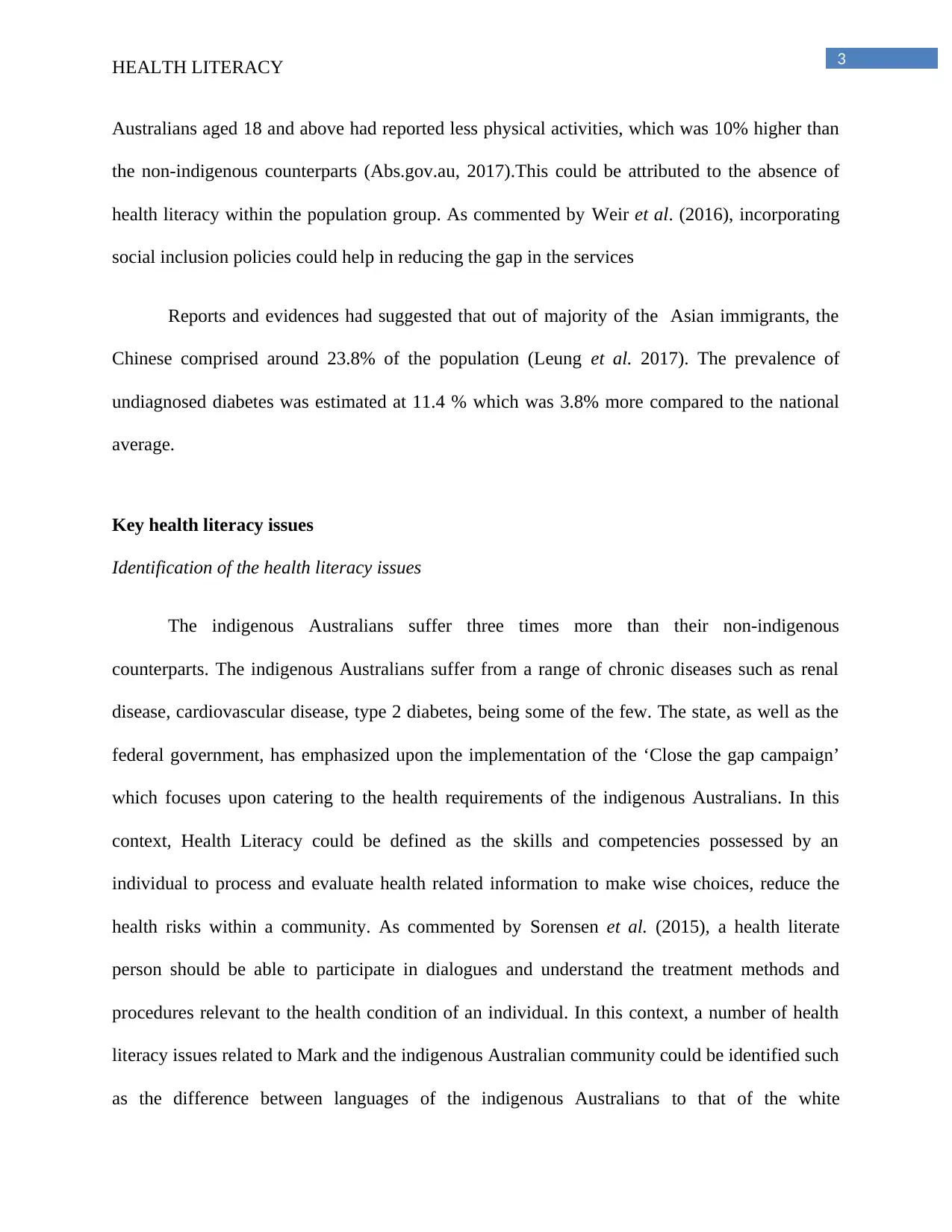
3HEALTH LITERACY
Australians aged 18 and above had reported less physical activities, which was 10% higher than
the non-indigenous counterparts (Abs.gov.au, 2017).This could be attributed to the absence of
health literacy within the population group. As commented by Weir et al. (2016), incorporating
social inclusion policies could help in reducing the gap in the services
Reports and evidences had suggested that out of majority of the Asian immigrants, the
Chinese comprised around 23.8% of the population (Leung et al. 2017). The prevalence of
undiagnosed diabetes was estimated at 11.4 % which was 3.8% more compared to the national
average.
Key health literacy issues
Identification of the health literacy issues
The indigenous Australians suffer three times more than their non-indigenous
counterparts. The indigenous Australians suffer from a range of chronic diseases such as renal
disease, cardiovascular disease, type 2 diabetes, being some of the few. The state, as well as the
federal government, has emphasized upon the implementation of the ‘Close the gap campaign’
which focuses upon catering to the health requirements of the indigenous Australians. In this
context, Health Literacy could be defined as the skills and competencies possessed by an
individual to process and evaluate health related information to make wise choices, reduce the
health risks within a community. As commented by Sorensen et al. (2015), a health literate
person should be able to participate in dialogues and understand the treatment methods and
procedures relevant to the health condition of an individual. In this context, a number of health
literacy issues related to Mark and the indigenous Australian community could be identified such
as the difference between languages of the indigenous Australians to that of the white
Australians aged 18 and above had reported less physical activities, which was 10% higher than
the non-indigenous counterparts (Abs.gov.au, 2017).This could be attributed to the absence of
health literacy within the population group. As commented by Weir et al. (2016), incorporating
social inclusion policies could help in reducing the gap in the services
Reports and evidences had suggested that out of majority of the Asian immigrants, the
Chinese comprised around 23.8% of the population (Leung et al. 2017). The prevalence of
undiagnosed diabetes was estimated at 11.4 % which was 3.8% more compared to the national
average.
Key health literacy issues
Identification of the health literacy issues
The indigenous Australians suffer three times more than their non-indigenous
counterparts. The indigenous Australians suffer from a range of chronic diseases such as renal
disease, cardiovascular disease, type 2 diabetes, being some of the few. The state, as well as the
federal government, has emphasized upon the implementation of the ‘Close the gap campaign’
which focuses upon catering to the health requirements of the indigenous Australians. In this
context, Health Literacy could be defined as the skills and competencies possessed by an
individual to process and evaluate health related information to make wise choices, reduce the
health risks within a community. As commented by Sorensen et al. (2015), a health literate
person should be able to participate in dialogues and understand the treatment methods and
procedures relevant to the health condition of an individual. In this context, a number of health
literacy issues related to Mark and the indigenous Australian community could be identified such
as the difference between languages of the indigenous Australians to that of the white
Secure Best Marks with AI Grader
Need help grading? Try our AI Grader for instant feedback on your assignments.

4HEALTH LITERACY
Australians. As asserted by Marzec et al. (2015), the world view professed by the indigenous
community also plays a significant role in shaping the health beliefs of an individual.
Role played by health literacy
The health literacy could be defined as a medium of delivering patient centred care along
with linguistically feasible services. The language and cultural differences in the context of the
CALD (Culturally and Linguistically Diverse) groups often hinder the process of easy and
effective communication (Beauchamp et al. 2015). However, as argued by Schulz and Nakamoto
(2013), the medical professionals at the same time need to incorporate patient centred care
approaches. Thus, advocating the health literacy principles within the hospital set up can help in
reducing the inequalities in health care.
Linking social disadvantage and health literacy
There exists a strong correlation between social disadvantage and health literacy, which
could further impact the health education and belief possessed by an individual. As commented
by Osborne et al. (2013), the social disadvantage could be further justified on basis of economic
crisis which often results in Aboriginal children dropping out of school. The social disadvantages
often result into negligence and loneliness, where an individual has a greater tendency of being
subjugated to peer pressures (Weir et al. 2016). In this context, Mark dropped out of school and
got into drinking and partying which affected his education and worldview on the whole. It has
been mentioned that both mark and his family do not believe in consulting the doctor and believe
every particular problem to be a community issue and not simply as health issues.
Australians. As asserted by Marzec et al. (2015), the world view professed by the indigenous
community also plays a significant role in shaping the health beliefs of an individual.
Role played by health literacy
The health literacy could be defined as a medium of delivering patient centred care along
with linguistically feasible services. The language and cultural differences in the context of the
CALD (Culturally and Linguistically Diverse) groups often hinder the process of easy and
effective communication (Beauchamp et al. 2015). However, as argued by Schulz and Nakamoto
(2013), the medical professionals at the same time need to incorporate patient centred care
approaches. Thus, advocating the health literacy principles within the hospital set up can help in
reducing the inequalities in health care.
Linking social disadvantage and health literacy
There exists a strong correlation between social disadvantage and health literacy, which
could further impact the health education and belief possessed by an individual. As commented
by Osborne et al. (2013), the social disadvantage could be further justified on basis of economic
crisis which often results in Aboriginal children dropping out of school. The social disadvantages
often result into negligence and loneliness, where an individual has a greater tendency of being
subjugated to peer pressures (Weir et al. 2016). In this context, Mark dropped out of school and
got into drinking and partying which affected his education and worldview on the whole. It has
been mentioned that both mark and his family do not believe in consulting the doctor and believe
every particular problem to be a community issue and not simply as health issues.
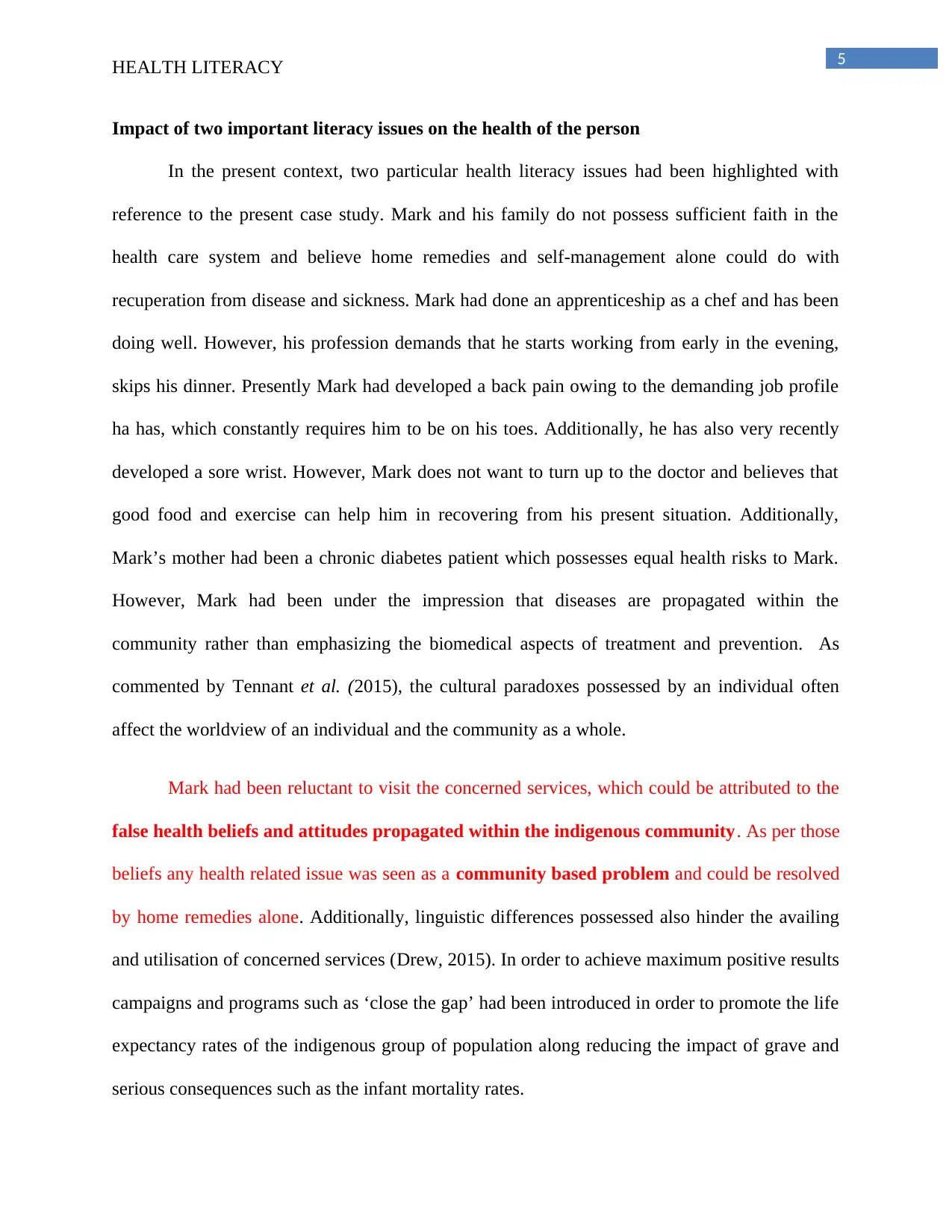
5HEALTH LITERACY
Impact of two important literacy issues on the health of the person
In the present context, two particular health literacy issues had been highlighted with
reference to the present case study. Mark and his family do not possess sufficient faith in the
health care system and believe home remedies and self-management alone could do with
recuperation from disease and sickness. Mark had done an apprenticeship as a chef and has been
doing well. However, his profession demands that he starts working from early in the evening,
skips his dinner. Presently Mark had developed a back pain owing to the demanding job profile
ha has, which constantly requires him to be on his toes. Additionally, he has also very recently
developed a sore wrist. However, Mark does not want to turn up to the doctor and believes that
good food and exercise can help him in recovering from his present situation. Additionally,
Mark’s mother had been a chronic diabetes patient which possesses equal health risks to Mark.
However, Mark had been under the impression that diseases are propagated within the
community rather than emphasizing the biomedical aspects of treatment and prevention. As
commented by Tennant et al. (2015), the cultural paradoxes possessed by an individual often
affect the worldview of an individual and the community as a whole.
Mark had been reluctant to visit the concerned services, which could be attributed to the
false health beliefs and attitudes propagated within the indigenous community. As per those
beliefs any health related issue was seen as a community based problem and could be resolved
by home remedies alone. Additionally, linguistic differences possessed also hinder the availing
and utilisation of concerned services (Drew, 2015). In order to achieve maximum positive results
campaigns and programs such as ‘close the gap’ had been introduced in order to promote the life
expectancy rates of the indigenous group of population along reducing the impact of grave and
serious consequences such as the infant mortality rates.
Impact of two important literacy issues on the health of the person
In the present context, two particular health literacy issues had been highlighted with
reference to the present case study. Mark and his family do not possess sufficient faith in the
health care system and believe home remedies and self-management alone could do with
recuperation from disease and sickness. Mark had done an apprenticeship as a chef and has been
doing well. However, his profession demands that he starts working from early in the evening,
skips his dinner. Presently Mark had developed a back pain owing to the demanding job profile
ha has, which constantly requires him to be on his toes. Additionally, he has also very recently
developed a sore wrist. However, Mark does not want to turn up to the doctor and believes that
good food and exercise can help him in recovering from his present situation. Additionally,
Mark’s mother had been a chronic diabetes patient which possesses equal health risks to Mark.
However, Mark had been under the impression that diseases are propagated within the
community rather than emphasizing the biomedical aspects of treatment and prevention. As
commented by Tennant et al. (2015), the cultural paradoxes possessed by an individual often
affect the worldview of an individual and the community as a whole.
Mark had been reluctant to visit the concerned services, which could be attributed to the
false health beliefs and attitudes propagated within the indigenous community. As per those
beliefs any health related issue was seen as a community based problem and could be resolved
by home remedies alone. Additionally, linguistic differences possessed also hinder the availing
and utilisation of concerned services (Drew, 2015). In order to achieve maximum positive results
campaigns and programs such as ‘close the gap’ had been introduced in order to promote the life
expectancy rates of the indigenous group of population along reducing the impact of grave and
serious consequences such as the infant mortality rates.
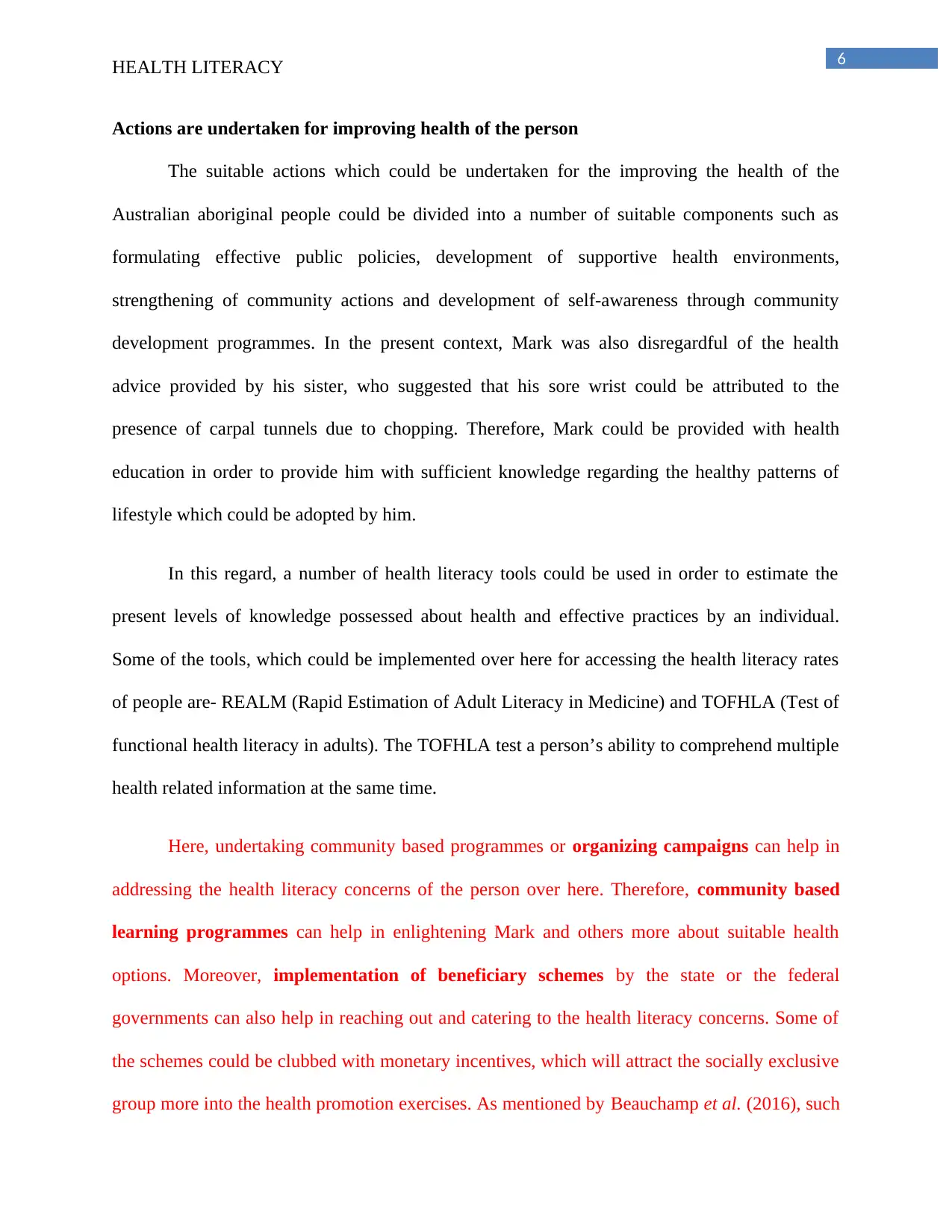
6HEALTH LITERACY
Actions are undertaken for improving health of the person
The suitable actions which could be undertaken for the improving the health of the
Australian aboriginal people could be divided into a number of suitable components such as
formulating effective public policies, development of supportive health environments,
strengthening of community actions and development of self-awareness through community
development programmes. In the present context, Mark was also disregardful of the health
advice provided by his sister, who suggested that his sore wrist could be attributed to the
presence of carpal tunnels due to chopping. Therefore, Mark could be provided with health
education in order to provide him with sufficient knowledge regarding the healthy patterns of
lifestyle which could be adopted by him.
In this regard, a number of health literacy tools could be used in order to estimate the
present levels of knowledge possessed about health and effective practices by an individual.
Some of the tools, which could be implemented over here for accessing the health literacy rates
of people are- REALM (Rapid Estimation of Adult Literacy in Medicine) and TOFHLA (Test of
functional health literacy in adults). The TOFHLA test a person’s ability to comprehend multiple
health related information at the same time.
Here, undertaking community based programmes or organizing campaigns can help in
addressing the health literacy concerns of the person over here. Therefore, community based
learning programmes can help in enlightening Mark and others more about suitable health
options. Moreover, implementation of beneficiary schemes by the state or the federal
governments can also help in reaching out and catering to the health literacy concerns. Some of
the schemes could be clubbed with monetary incentives, which will attract the socially exclusive
group more into the health promotion exercises. As mentioned by Beauchamp et al. (2016), such
Actions are undertaken for improving health of the person
The suitable actions which could be undertaken for the improving the health of the
Australian aboriginal people could be divided into a number of suitable components such as
formulating effective public policies, development of supportive health environments,
strengthening of community actions and development of self-awareness through community
development programmes. In the present context, Mark was also disregardful of the health
advice provided by his sister, who suggested that his sore wrist could be attributed to the
presence of carpal tunnels due to chopping. Therefore, Mark could be provided with health
education in order to provide him with sufficient knowledge regarding the healthy patterns of
lifestyle which could be adopted by him.
In this regard, a number of health literacy tools could be used in order to estimate the
present levels of knowledge possessed about health and effective practices by an individual.
Some of the tools, which could be implemented over here for accessing the health literacy rates
of people are- REALM (Rapid Estimation of Adult Literacy in Medicine) and TOFHLA (Test of
functional health literacy in adults). The TOFHLA test a person’s ability to comprehend multiple
health related information at the same time.
Here, undertaking community based programmes or organizing campaigns can help in
addressing the health literacy concerns of the person over here. Therefore, community based
learning programmes can help in enlightening Mark and others more about suitable health
options. Moreover, implementation of beneficiary schemes by the state or the federal
governments can also help in reaching out and catering to the health literacy concerns. Some of
the schemes could be clubbed with monetary incentives, which will attract the socially exclusive
group more into the health promotion exercises. As mentioned by Beauchamp et al. (2016), such
Paraphrase This Document
Need a fresh take? Get an instant paraphrase of this document with our AI Paraphraser
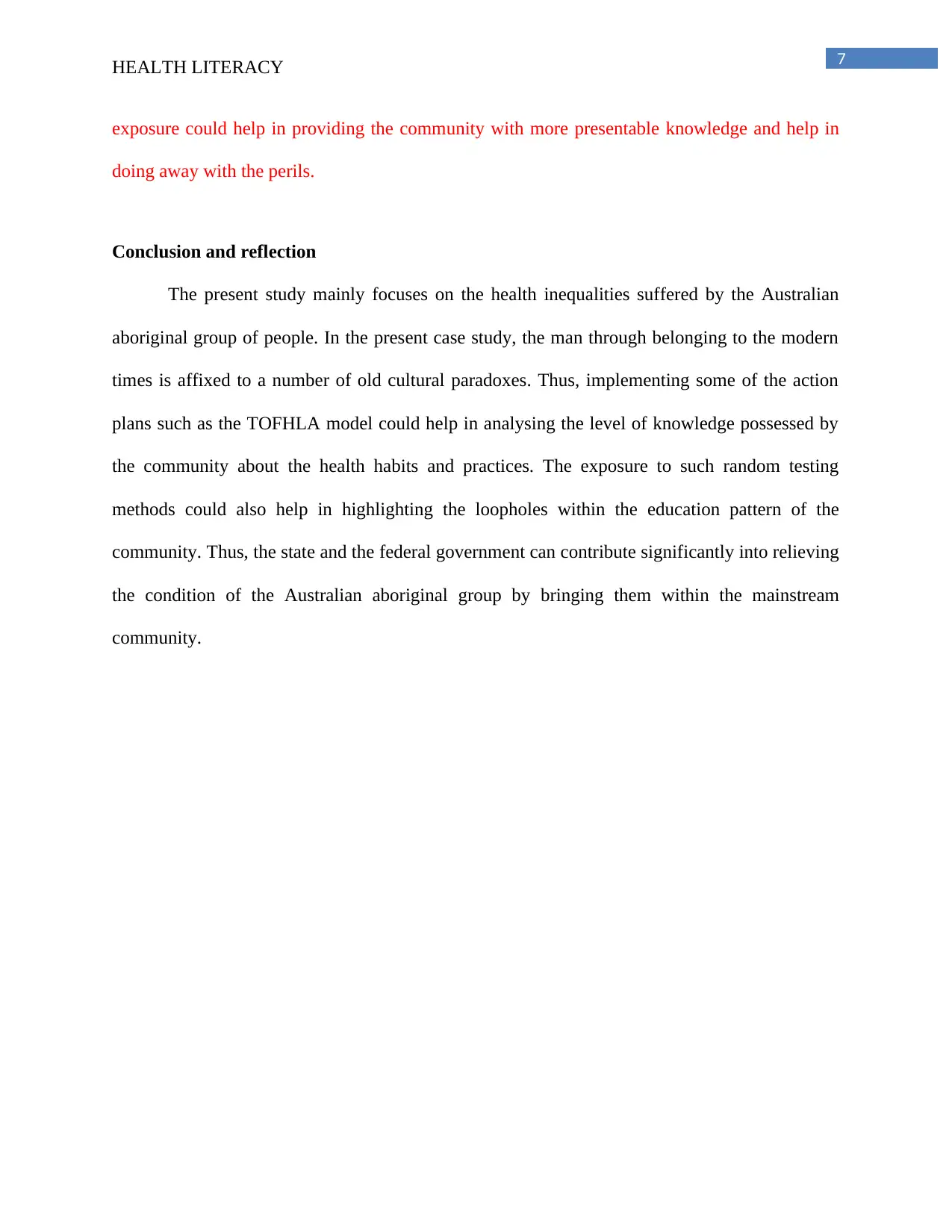
7HEALTH LITERACY
exposure could help in providing the community with more presentable knowledge and help in
doing away with the perils.
Conclusion and reflection
The present study mainly focuses on the health inequalities suffered by the Australian
aboriginal group of people. In the present case study, the man through belonging to the modern
times is affixed to a number of old cultural paradoxes. Thus, implementing some of the action
plans such as the TOFHLA model could help in analysing the level of knowledge possessed by
the community about the health habits and practices. The exposure to such random testing
methods could also help in highlighting the loopholes within the education pattern of the
community. Thus, the state and the federal government can contribute significantly into relieving
the condition of the Australian aboriginal group by bringing them within the mainstream
community.
exposure could help in providing the community with more presentable knowledge and help in
doing away with the perils.
Conclusion and reflection
The present study mainly focuses on the health inequalities suffered by the Australian
aboriginal group of people. In the present case study, the man through belonging to the modern
times is affixed to a number of old cultural paradoxes. Thus, implementing some of the action
plans such as the TOFHLA model could help in analysing the level of knowledge possessed by
the community about the health habits and practices. The exposure to such random testing
methods could also help in highlighting the loopholes within the education pattern of the
community. Thus, the state and the federal government can contribute significantly into relieving
the condition of the Australian aboriginal group by bringing them within the mainstream
community.
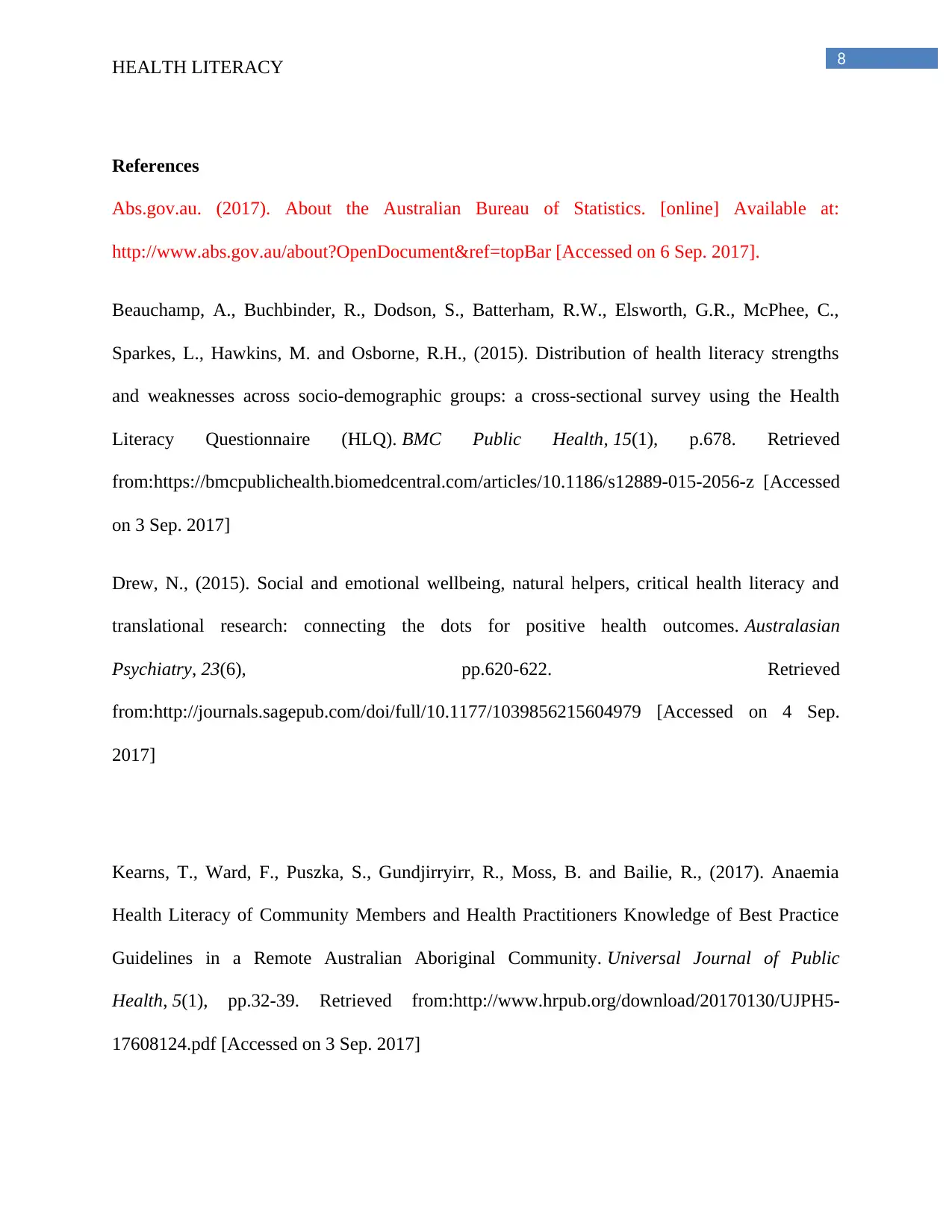
8HEALTH LITERACY
References
Abs.gov.au. (2017). About the Australian Bureau of Statistics. [online] Available at:
http://www.abs.gov.au/about?OpenDocument&ref=topBar [Accessed on 6 Sep. 2017].
Beauchamp, A., Buchbinder, R., Dodson, S., Batterham, R.W., Elsworth, G.R., McPhee, C.,
Sparkes, L., Hawkins, M. and Osborne, R.H., (2015). Distribution of health literacy strengths
and weaknesses across socio-demographic groups: a cross-sectional survey using the Health
Literacy Questionnaire (HLQ). BMC Public Health, 15(1), p.678. Retrieved
from:https://bmcpublichealth.biomedcentral.com/articles/10.1186/s12889-015-2056-z [Accessed
on 3 Sep. 2017]
Drew, N., (2015). Social and emotional wellbeing, natural helpers, critical health literacy and
translational research: connecting the dots for positive health outcomes. Australasian
Psychiatry, 23(6), pp.620-622. Retrieved
from:http://journals.sagepub.com/doi/full/10.1177/1039856215604979 [Accessed on 4 Sep.
2017]
Kearns, T., Ward, F., Puszka, S., Gundjirryirr, R., Moss, B. and Bailie, R., (2017). Anaemia
Health Literacy of Community Members and Health Practitioners Knowledge of Best Practice
Guidelines in a Remote Australian Aboriginal Community. Universal Journal of Public
Health, 5(1), pp.32-39. Retrieved from:http://www.hrpub.org/download/20170130/UJPH5-
17608124.pdf [Accessed on 3 Sep. 2017]
References
Abs.gov.au. (2017). About the Australian Bureau of Statistics. [online] Available at:
http://www.abs.gov.au/about?OpenDocument&ref=topBar [Accessed on 6 Sep. 2017].
Beauchamp, A., Buchbinder, R., Dodson, S., Batterham, R.W., Elsworth, G.R., McPhee, C.,
Sparkes, L., Hawkins, M. and Osborne, R.H., (2015). Distribution of health literacy strengths
and weaknesses across socio-demographic groups: a cross-sectional survey using the Health
Literacy Questionnaire (HLQ). BMC Public Health, 15(1), p.678. Retrieved
from:https://bmcpublichealth.biomedcentral.com/articles/10.1186/s12889-015-2056-z [Accessed
on 3 Sep. 2017]
Drew, N., (2015). Social and emotional wellbeing, natural helpers, critical health literacy and
translational research: connecting the dots for positive health outcomes. Australasian
Psychiatry, 23(6), pp.620-622. Retrieved
from:http://journals.sagepub.com/doi/full/10.1177/1039856215604979 [Accessed on 4 Sep.
2017]
Kearns, T., Ward, F., Puszka, S., Gundjirryirr, R., Moss, B. and Bailie, R., (2017). Anaemia
Health Literacy of Community Members and Health Practitioners Knowledge of Best Practice
Guidelines in a Remote Australian Aboriginal Community. Universal Journal of Public
Health, 5(1), pp.32-39. Retrieved from:http://www.hrpub.org/download/20170130/UJPH5-
17608124.pdf [Accessed on 3 Sep. 2017]
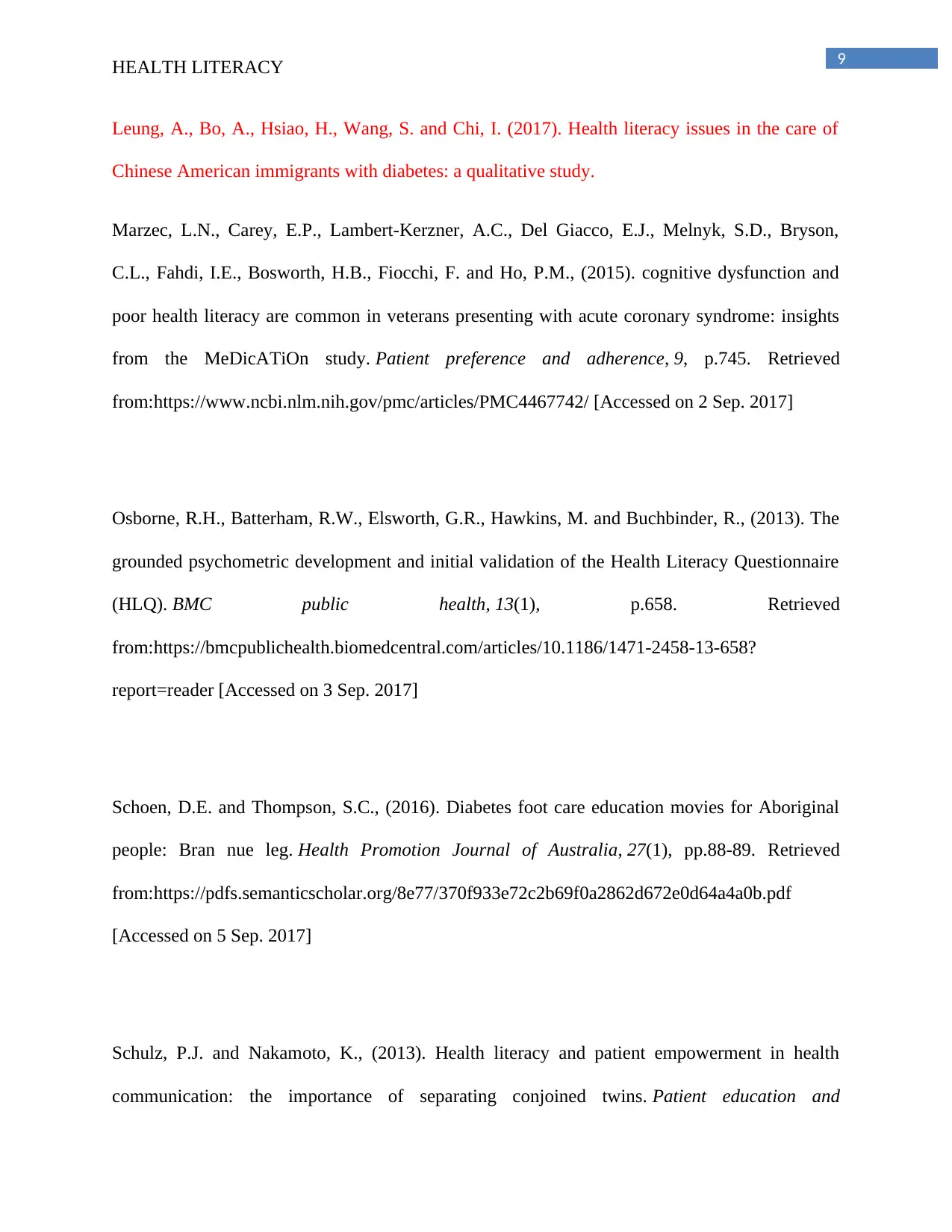
9HEALTH LITERACY
Leung, A., Bo, A., Hsiao, H., Wang, S. and Chi, I. (2017). Health literacy issues in the care of
Chinese American immigrants with diabetes: a qualitative study.
Marzec, L.N., Carey, E.P., Lambert-Kerzner, A.C., Del Giacco, E.J., Melnyk, S.D., Bryson,
C.L., Fahdi, I.E., Bosworth, H.B., Fiocchi, F. and Ho, P.M., (2015). cognitive dysfunction and
poor health literacy are common in veterans presenting with acute coronary syndrome: insights
from the MeDicATiOn study. Patient preference and adherence, 9, p.745. Retrieved
from:https://www.ncbi.nlm.nih.gov/pmc/articles/PMC4467742/ [Accessed on 2 Sep. 2017]
Osborne, R.H., Batterham, R.W., Elsworth, G.R., Hawkins, M. and Buchbinder, R., (2013). The
grounded psychometric development and initial validation of the Health Literacy Questionnaire
(HLQ). BMC public health, 13(1), p.658. Retrieved
from:https://bmcpublichealth.biomedcentral.com/articles/10.1186/1471-2458-13-658?
report=reader [Accessed on 3 Sep. 2017]
Schoen, D.E. and Thompson, S.C., (2016). Diabetes foot care education movies for Aboriginal
people: Bran nue leg. Health Promotion Journal of Australia, 27(1), pp.88-89. Retrieved
from:https://pdfs.semanticscholar.org/8e77/370f933e72c2b69f0a2862d672e0d64a4a0b.pdf
[Accessed on 5 Sep. 2017]
Schulz, P.J. and Nakamoto, K., (2013). Health literacy and patient empowerment in health
communication: the importance of separating conjoined twins. Patient education and
Leung, A., Bo, A., Hsiao, H., Wang, S. and Chi, I. (2017). Health literacy issues in the care of
Chinese American immigrants with diabetes: a qualitative study.
Marzec, L.N., Carey, E.P., Lambert-Kerzner, A.C., Del Giacco, E.J., Melnyk, S.D., Bryson,
C.L., Fahdi, I.E., Bosworth, H.B., Fiocchi, F. and Ho, P.M., (2015). cognitive dysfunction and
poor health literacy are common in veterans presenting with acute coronary syndrome: insights
from the MeDicATiOn study. Patient preference and adherence, 9, p.745. Retrieved
from:https://www.ncbi.nlm.nih.gov/pmc/articles/PMC4467742/ [Accessed on 2 Sep. 2017]
Osborne, R.H., Batterham, R.W., Elsworth, G.R., Hawkins, M. and Buchbinder, R., (2013). The
grounded psychometric development and initial validation of the Health Literacy Questionnaire
(HLQ). BMC public health, 13(1), p.658. Retrieved
from:https://bmcpublichealth.biomedcentral.com/articles/10.1186/1471-2458-13-658?
report=reader [Accessed on 3 Sep. 2017]
Schoen, D.E. and Thompson, S.C., (2016). Diabetes foot care education movies for Aboriginal
people: Bran nue leg. Health Promotion Journal of Australia, 27(1), pp.88-89. Retrieved
from:https://pdfs.semanticscholar.org/8e77/370f933e72c2b69f0a2862d672e0d64a4a0b.pdf
[Accessed on 5 Sep. 2017]
Schulz, P.J. and Nakamoto, K., (2013). Health literacy and patient empowerment in health
communication: the importance of separating conjoined twins. Patient education and
Secure Best Marks with AI Grader
Need help grading? Try our AI Grader for instant feedback on your assignments.
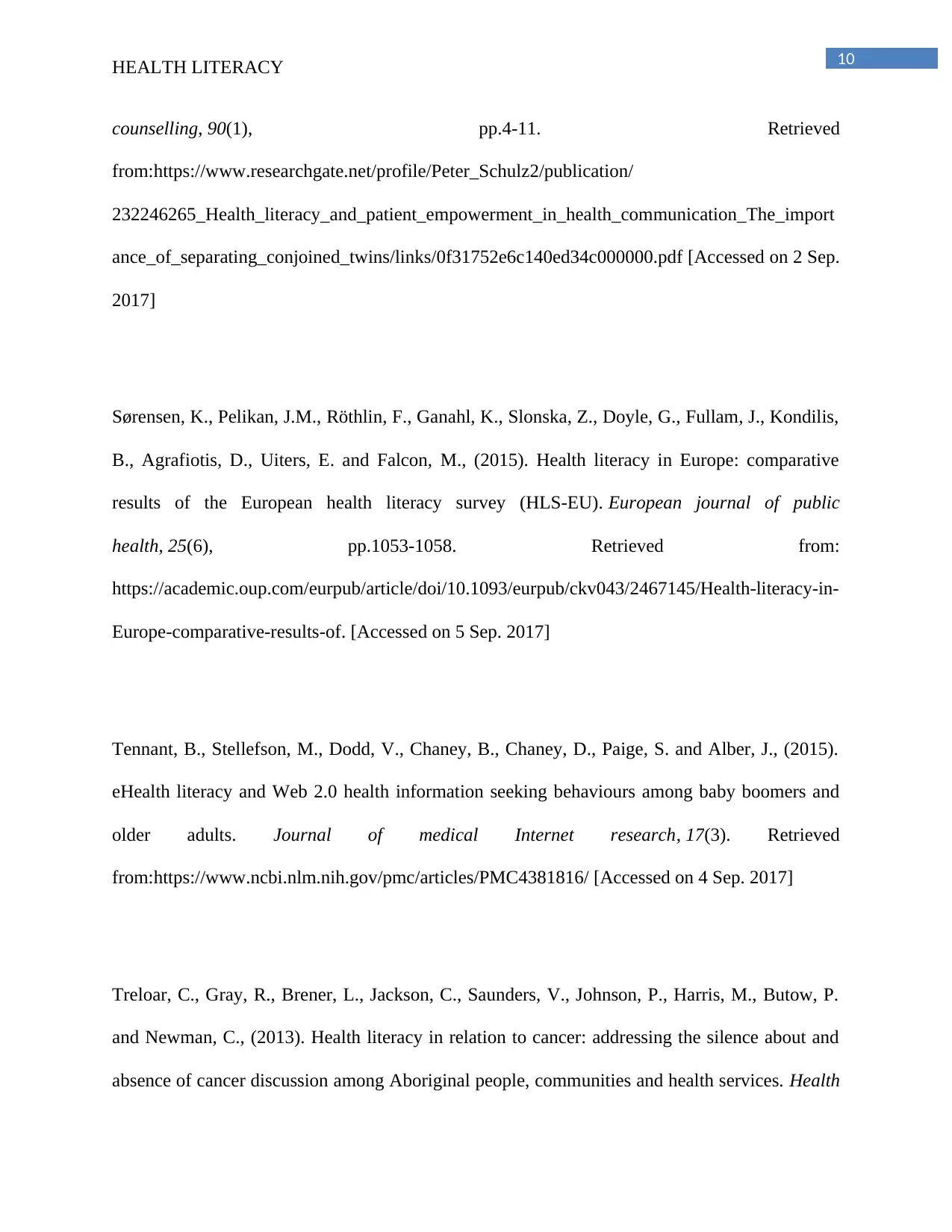
10HEALTH LITERACY
counselling, 90(1), pp.4-11. Retrieved
from:https://www.researchgate.net/profile/Peter_Schulz2/publication/
232246265_Health_literacy_and_patient_empowerment_in_health_communication_The_import
ance_of_separating_conjoined_twins/links/0f31752e6c140ed34c000000.pdf [Accessed on 2 Sep.
2017]
Sørensen, K., Pelikan, J.M., Röthlin, F., Ganahl, K., Slonska, Z., Doyle, G., Fullam, J., Kondilis,
B., Agrafiotis, D., Uiters, E. and Falcon, M., (2015). Health literacy in Europe: comparative
results of the European health literacy survey (HLS-EU). European journal of public
health, 25(6), pp.1053-1058. Retrieved from:
https://academic.oup.com/eurpub/article/doi/10.1093/eurpub/ckv043/2467145/Health-literacy-in-
Europe-comparative-results-of. [Accessed on 5 Sep. 2017]
Tennant, B., Stellefson, M., Dodd, V., Chaney, B., Chaney, D., Paige, S. and Alber, J., (2015).
eHealth literacy and Web 2.0 health information seeking behaviours among baby boomers and
older adults. Journal of medical Internet research, 17(3). Retrieved
from:https://www.ncbi.nlm.nih.gov/pmc/articles/PMC4381816/ [Accessed on 4 Sep. 2017]
Treloar, C., Gray, R., Brener, L., Jackson, C., Saunders, V., Johnson, P., Harris, M., Butow, P.
and Newman, C., (2013). Health literacy in relation to cancer: addressing the silence about and
absence of cancer discussion among Aboriginal people, communities and health services. Health
counselling, 90(1), pp.4-11. Retrieved
from:https://www.researchgate.net/profile/Peter_Schulz2/publication/
232246265_Health_literacy_and_patient_empowerment_in_health_communication_The_import
ance_of_separating_conjoined_twins/links/0f31752e6c140ed34c000000.pdf [Accessed on 2 Sep.
2017]
Sørensen, K., Pelikan, J.M., Röthlin, F., Ganahl, K., Slonska, Z., Doyle, G., Fullam, J., Kondilis,
B., Agrafiotis, D., Uiters, E. and Falcon, M., (2015). Health literacy in Europe: comparative
results of the European health literacy survey (HLS-EU). European journal of public
health, 25(6), pp.1053-1058. Retrieved from:
https://academic.oup.com/eurpub/article/doi/10.1093/eurpub/ckv043/2467145/Health-literacy-in-
Europe-comparative-results-of. [Accessed on 5 Sep. 2017]
Tennant, B., Stellefson, M., Dodd, V., Chaney, B., Chaney, D., Paige, S. and Alber, J., (2015).
eHealth literacy and Web 2.0 health information seeking behaviours among baby boomers and
older adults. Journal of medical Internet research, 17(3). Retrieved
from:https://www.ncbi.nlm.nih.gov/pmc/articles/PMC4381816/ [Accessed on 4 Sep. 2017]
Treloar, C., Gray, R., Brener, L., Jackson, C., Saunders, V., Johnson, P., Harris, M., Butow, P.
and Newman, C., (2013). Health literacy in relation to cancer: addressing the silence about and
absence of cancer discussion among Aboriginal people, communities and health services. Health
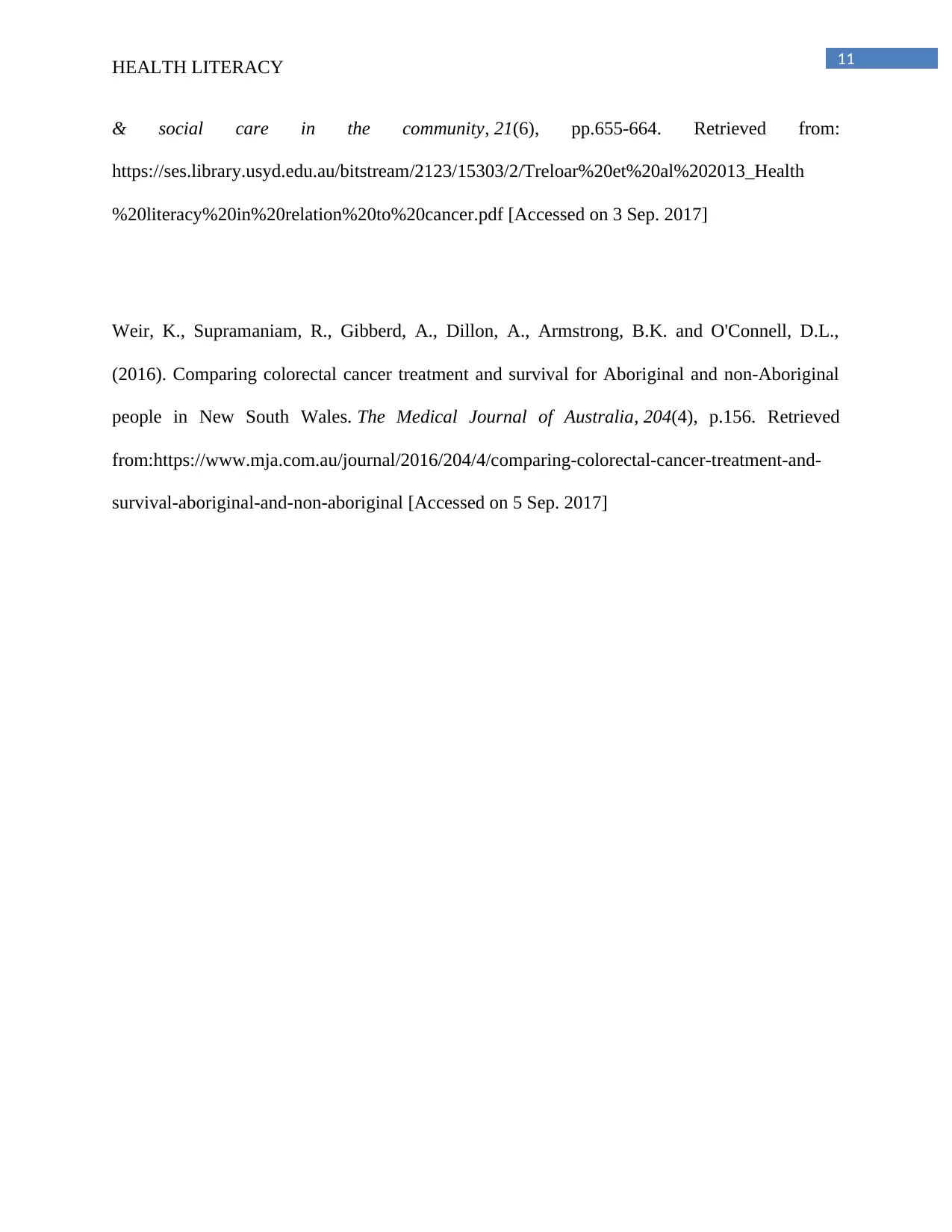
11HEALTH LITERACY
& social care in the community, 21(6), pp.655-664. Retrieved from:
https://ses.library.usyd.edu.au/bitstream/2123/15303/2/Treloar%20et%20al%202013_Health
%20literacy%20in%20relation%20to%20cancer.pdf [Accessed on 3 Sep. 2017]
Weir, K., Supramaniam, R., Gibberd, A., Dillon, A., Armstrong, B.K. and O'Connell, D.L.,
(2016). Comparing colorectal cancer treatment and survival for Aboriginal and non-Aboriginal
people in New South Wales. The Medical Journal of Australia, 204(4), p.156. Retrieved
from:https://www.mja.com.au/journal/2016/204/4/comparing-colorectal-cancer-treatment-and-
survival-aboriginal-and-non-aboriginal [Accessed on 5 Sep. 2017]
& social care in the community, 21(6), pp.655-664. Retrieved from:
https://ses.library.usyd.edu.au/bitstream/2123/15303/2/Treloar%20et%20al%202013_Health
%20literacy%20in%20relation%20to%20cancer.pdf [Accessed on 3 Sep. 2017]
Weir, K., Supramaniam, R., Gibberd, A., Dillon, A., Armstrong, B.K. and O'Connell, D.L.,
(2016). Comparing colorectal cancer treatment and survival for Aboriginal and non-Aboriginal
people in New South Wales. The Medical Journal of Australia, 204(4), p.156. Retrieved
from:https://www.mja.com.au/journal/2016/204/4/comparing-colorectal-cancer-treatment-and-
survival-aboriginal-and-non-aboriginal [Accessed on 5 Sep. 2017]
1 out of 12
Your All-in-One AI-Powered Toolkit for Academic Success.
+13062052269
info@desklib.com
Available 24*7 on WhatsApp / Email
![[object Object]](/_next/static/media/star-bottom.7253800d.svg)
Unlock your academic potential
© 2024 | Zucol Services PVT LTD | All rights reserved.





